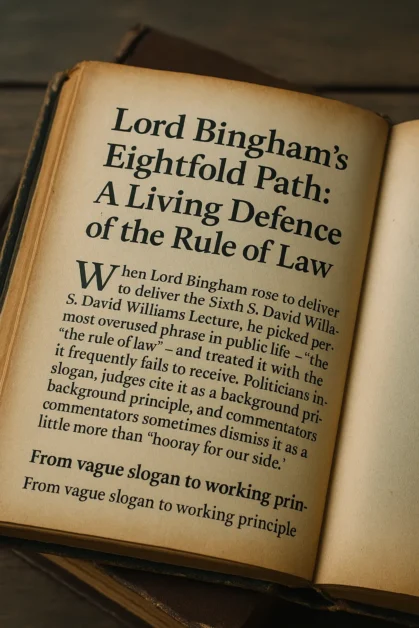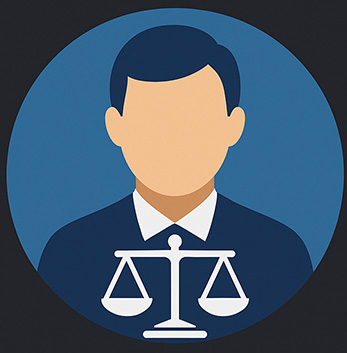Lord Bingham’s Eightfold Path: A Living Defence of the Rule of Law
When Lord Bingham rose to deliver the Sixth S. David Williams Lecture, he picked perhaps the most overused phrase in public life – “the rule of law” – and treated it with the seriousness it frequently fails to receive. Politicians invoke it as a slogan, judges cite it as a background principle, and commentators sometimes dismiss it as little more than “hooray for our side.” Bingham’s achievement in this lecture is to take that overworked phrase, peel away the rhetoric, and rebuild it into a structured, practical, and morally serious doctrine.
This article explores what Bingham says, how he says it, and why his vision of the rule of law still matters – while also asking where his analysis might be stretched further.
From vague slogan to working principle
Bingham starts from a constitutional curiosity. The Constitutional Reform Act 2005 solemnly declares that nothing in the Act is to “adversely affect the existing constitutional principle of the rule of law,” and that the Lord Chancellor must “respect the rule of law and defend the independence of the judiciary.”
This sounds grand – but the Act never defines what the “existing constitutional principle” actually is. Parliament has entrenched a principle it declined to explain.
Bingham notes that judges have long invoked the rule of law, but rarely defined it; theorists like Joseph Raz, John Finnis, and others have criticised the phrase as elusive, overused, or even meaningless. Yet Parliament has now treated it as a real, binding constitutional principle. That, Bingham argues, leaves judges with no luxury of dismissing it as “meaningless verbiage.” It must be taken seriously.
He offers a core definition:
All persons and authorities within the state, whether public or private, should be bound by and entitled to the benefit of laws publicly and prospectively promulgated and publicly administered in the courts.
This is classic Bingham: clear, modest, and grounded in practice. But he immediately acknowledges that this cannot operate without exceptions or qualifications and that the rule of law, as a constitutional principle, has evolved and will continue to evolve. To understand what it demands “in this country today,” he breaks it into eight “sub-rules” – a move that turns an abstract ideal into a working checklist.
1. Law must be accessible, intelligible, and predictable
Bingham’s first sub-rule sounds simple but is quietly radical: people cannot be bound by laws they cannot reasonably discover or understand.
In his hands, this goes beyond a truism. He points to legislative “hyperactivity”: thousands of pages of primary legislation and tens of thousands of pages of statutory instruments, drafted with dense cross-references and technical language. Internet access has not solved the problem; it has merely changed the way we drown.
Bingham is refreshingly candid that judges are part of the problem. Lengthy, highly technical appellate judgments may show “technical virtuosity” but can also make the law opaque to those who must live under it. He rejects the idea that there should always be a single, monolithic judgment in major cases, valuing instead the diversity of reasoning that multiple speeches provide. But he adds important caveats: judges must strive to identify a clear majority ratio and avoid changing the law in ways that are unforeseeable, especially in criminal law, where retroactive creation of offences would be a direct assault on the rule of law.
Critical appreciation:
Here, Bingham is at his strongest – combining doctrinal clarity with institutional self-awareness. His insistence that clarity is itself a constitutional value is an important counter to both sprawling statutes and self-indulgent judgments. The only weakness is that his remedy is more exhortation than mechanism: he calls for clearer judgments and laws, but leaves open how structural incentives – political or judicial – will change to deliver that clarity.
2. Rights and liabilities must be determined by law, not by unfettered discretion
Bingham’s second sub-rule targets arbitrary power: questions of legal right and liability should ordinarily be resolved by the application of law, not by broad discretion.
He doesn’t go as far as Dicey’s near-phobic hostility to discretion, but insists on an important distinction: discretion should be constrained by principles and capable of reasoned justification. The more “loosely textured” a discretion, the greater the scope for subjectivity and arbitrariness – the antithesis of the rule of law.
Here Bingham is particularly incisive when he points out that:
- There is no discretion about facts: if the evidence compels a factual conclusion, the decision-maker cannot simply “choose” another one.
- Many so-called discretions are, once relevant judgments are made, effectively determined.
- Even familiar judicial discretions – such as granting an injunction or excluding evidence – are hemmed in by principles, not free-floating choices.
On this view, talk of “unfettered discretion” is a contradiction in terms. The rule of law requires that all official power, including discretionary power, be disciplined by legal standards.
Critical appreciation:
This is a subtle but important corrective to both political rhetoric and lazy legal reasoning. Bingham’s account shows that the rule of law is not about eliminating discretion, but about civilising it. Where one might push him further is on soft power: the unwritten pressures, institutional cultures, and “hidden” discretions that are not easily captured by formal rules but still shape outcomes. His analysis is strong on formal discretion; less so on informal, practical power.
3. The law should apply equally – with justified exceptions
Bingham’s third sub-rule is equality before the law, with the crucial qualification: differences in treatment must rest on objective differences relevant to the law’s purpose.
He uses historical examples to show how far we have come – and how far we sometimes fall short:
- Medieval statutes targeting individuals (like the cook boiled to death by special Act of Parliament).
- Legal disabilities imposed on Catholics, Dissenters, Jews, and women.
- Contemporary discrimination between nationals and non-nationals, especially in security legislation.
He quotes Lord Scarman in Khawaja: everyone within the jurisdiction, citizen or not, is entitled to the equal protection of the law. Yet Parliament’s attempt to detain foreign terror suspects indefinitely, while exempting equally dangerous nationals, is a clear example of how the rule of law can be compromised under the pressure of security fears.
Critical appreciation:
Bingham’s insistence that equality before the law applies to non-nationals as well as citizens is one of the lecture’s most powerful themes. He exposes the temptation to treat outsiders as second-class bearers of legal protection, especially in times of crisis. At the same time, his analysis remains largely within the frame of civil and political equality. He does not engage deeply with socio-economic inequality – the ways in which poverty, class, and structural disadvantage can hollow out formal equality before the law.
4. The rule of law must protect fundamental human rights
This is the most controversial and philosophically rich part of Bingham’s lecture.
Legal theorists like Raz argue that a system can comply perfectly with the rule of law while still being morally abhorrent – for example, a regime that enacts racist or exploitative laws but applies them with scrupulous procedural fairness. The rule of law, on that view, is a formal virtue of law, not a moral one.
Bingham firmly – and persuasively – resists this. A state that legally enacts and efficiently enforces laws sending minorities to camps or forcing infanticide cannot, in his view, be said to respect the rule of law in any meaningful sense. To say otherwise would be to strip the principle of its moral content and render Parliament’s reference to it largely empty.
At the same time, he is realistic. There is no universally agreed list of fundamental rights, and different societies draw lines differently – he uses the death penalty as a prime example. For him, the rule of law requires protection of those rights that a particular society broadly recognises as fundamental, with courts drawing lines at the margins, subject to statute.
Critical appreciation:
This is classic Bingham: cautious, pragmatic, and yet morally anchored. He refuses to let the rule of law become a purely technical concept, but also avoids turning it into a free-floating wish list of all good things. The price of this balance, however, is a certain relativism: if fundamental rights are defined largely by national consensus, what of societies where that consensus is illiberal? Bingham’s approach gives courts space to resist, but not an entirely clear standard from which to do so.
5. There must be effective access to justice
If everyone is “bound by and entitled to the benefit of the law,” then people must have realistic access to courts to vindicate their rights. Bingham insists that means of resolving genuine civil disputes must be available without prohibitive cost or inordinate delay.
He is careful not to disparage arbitration, mediation, or other forms of alternative dispute resolution; indeed, he praises them when fairly conducted. But he stresses that the right of access to a court is a basic component of the rule of law.
This leads him straight into legal aid and court fees. He recalls the bold post-war creation of civil legal aid, and its subsequent erosion under cost pressures and political hostility. He worries that tabloid narratives about “fat cat lawyers” have helped justify the dismantling of a vital instrument of social justice. He is equally sceptical of the idea that civil courts should be self-financing through high fees, treating the provision of courts as a core function of a liberal democratic state, not just a revenue service.
Critical appreciation:
Bingham’s language here is almost elegiac, and it is one of the lecture’s most socially aware passages. He recognises that a right you cannot afford to enforce is a right in name only. Where his analysis could be deepened is in confronting the structural underfunding of justice systems as a political choice, not a technocratic inevitability. Still, his articulation of access to justice as a pillar of the rule of law remains a powerful counter to austerity-driven reforms.
6 & 7. Proper exercise of public power and fair adjudicative procedures
Two of Bingham’s sub-rules concern the way state power is exercised and disputes are adjudicated:
- Ministers and public officers must act within their powers, reasonably, in good faith, for proper purposes, and within legal limits.
- Adjudicative procedures must be fair, especially where individuals face serious consequences.
These principles underpin modern judicial review. Bingham emphasises the “proper tension” between courts and government: if governments never lose in court, that is not a sign of health but a warning. He is critical of attacks by ministers on judges, seeing them as corrosive of constitutional balance.
On fair procedures, he restates core principles: independence and impartiality of adjudicators, the right to be heard, disclosure of material, time to prepare, legal assistance where necessary, and the presumption of innocence in criminal cases. He is especially uneasy about growing categories of cases – particularly in the security context – where the full case against a person is not disclosed to them or their lawyer. Such secret processes, even if legally authorised, sit uneasily with the rule of law.
Critical appreciation:
These parts of the lecture show Bingham in his natural element as a public lawyer. His defence of judicial review and procedural fairness is firm but not shrill, and he recognises genuine security concerns without capitulating to them. His analysis of “open war” rhetoric between ministers and judges is prescient: he understands that mutual restraint is itself a constitutional value. The unresolved tension is this: if Parliament explicitly authorises unfair procedures, does the rule of law require courts to strike them down, or merely to protest? Bingham’s answer is cautious, but the dilemma remains.
8. The state must respect its international legal obligations
Bingham’s final sub-rule extends the rule of law beyond national borders: a state that disregards binding international law is not fully respecting the rule of law.
He contrasts early 20th-century casualness about international law – “necessity knows no law,” “keep the lawyers out of it” – with more modern practice, where governments at least feel compelled to justify their actions in legal terms. His comparison between the Suez invasion (1956) and the Iraq war (2003) is revealing: in 1956, the government proceeded in knowing defiance of legal advice; in 2003, whatever one’s view of the war’s legality, the process showed a far greater concern to ground action in some form of legal argument.
For Bingham, lawyers advising government on matters as grave as war hold a special constitutional position. He questions whether ordinary rules of client–lawyer privilege should apply to law officers’ opinions on the legality of war, arguing that the public – those who may fight and die – are, in a real sense, the true “client.”
Critical appreciation:
This is one of the lecture’s more daring claims. Bingham pushes the rule of law into the international realm and treats legal argument about war not as a diplomatic nicety but as a constitutional duty. His critique of secrecy around law officers’ advice is particularly striking. Some may say he underestimates the political realities of foreign policy; yet the point of a constitutional principle is precisely to provide a standard against which those realities can be judged.
The “bargain” at the heart of the rule of law
Bingham closes on a note that is both philosophical and quietly stirring. The rule of law, he suggests, rests on an unspoken bargain:
- Individuals accept restrictions on their freedom – they cannot live with the boundless liberty of “Adam in the Garden of Eden” – because law, overall, brings order and protection.
- The state, in return, accepts that it may not do everything it has the power to do, but only what it is legally authorised to do, at home and abroad.
This mutual self-limitation, he argues, is what turns law from a mere instrument of control into a “sacred flame” that animates and enlightens society. Lawyers, judges, academics, and others who serve the law are not guardians of dry rules, but of this fragile bargain.
Critical appreciation:
This conclusion is perhaps the most beautiful part of the lecture. It lifts the discussion from doctrinal detail to constitutional ethics. Yet it also points to the vulnerability of the rule of law: when either side – citizen or state – breaks the bargain, the flame dims. Citizens who ignore law, or states that treat law as a tool rather than a restraint, both erode the very thing they rely on.
Why Bingham’s lecture still matters
Bingham’s eight sub-rules do not claim to be the last word on the rule of law. He admits others might draw the lines differently or add to his list. But their strength lies in their operational clarity. They give judges, lawyers, legislators, and citizens a way to ask concrete questions:
- Is the law clear enough to be followed?
- Is discretion constrained and reasoned, or arbitrary?
- Is equality before the law real, or selectively suspended?
- Are fundamental rights protected, or treated as optional?
- Can ordinary people access justice without ruin?
- Are public powers exercised within proper limits?
- Are procedures fair, especially when stakes are highest?
- Does the state keep its word in international law?
As an intellectual project, the lecture is elegant and coherent. As a constitutional intervention, it is quietly radical: it insists that the rule of law is not just about neat statutes and tidy courts, but about fairness, restraint, equality, and accountability in practice.
If there is a criticism to be made, it is that Bingham’s approach sometimes relies heavily on the good faith of institutions – on judges exercising self-restraint, governments respecting judicial independence, Parliament internalising constitutional norms, and society agreeing broadly on what rights are “fundamental.” In an era of polarisation and populist pressure, those assumptions may feel optimistic.
Yet that is also why his lecture remains so valuable. It reminds us that the rule of law is not self-executing. It depends on habits, culture, and courage – of judges who draw lines, of lawyers who argue unpopular causes, of legislators who resist easy shortcuts, and of citizens who insist that power must answer to law.
Bingham’s voice in this lecture is calm, measured, and never theatrical. But beneath that composure lies a deeply felt conviction: that to work in and for the law is not to tend a dusty archive of rules, but to guard a living principle on which a free society rests.










